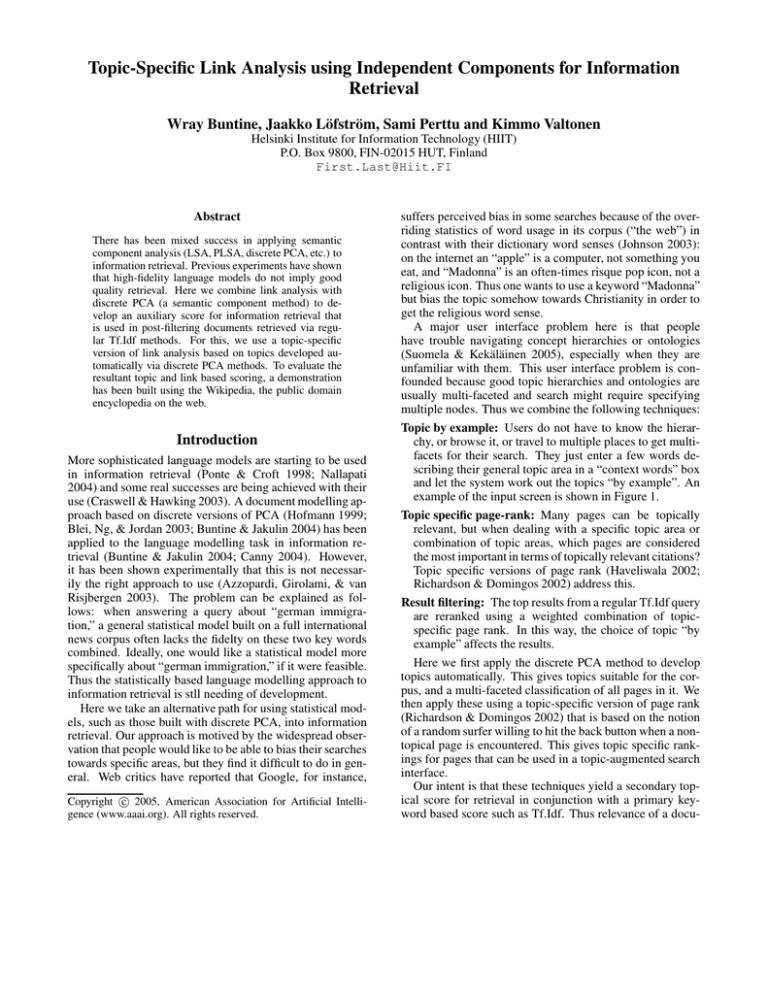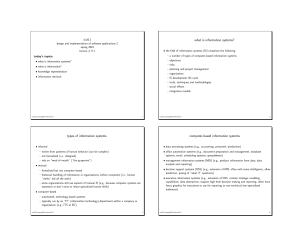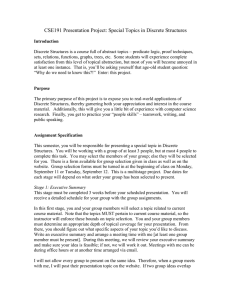
Topic-Specific Link Analysis using Independent Components for Information
Retrieval
Wray Buntine, Jaakko Löfström, Sami Perttu and Kimmo Valtonen
Helsinki Institute for Information Technology (HIIT)
P.O. Box 9800, FIN-02015 HUT, Finland
First.Last@Hiit.FI
Abstract
There has been mixed success in applying semantic
component analysis (LSA, PLSA, discrete PCA, etc.) to
information retrieval. Previous experiments have shown
that high-fidelity language models do not imply good
quality retrieval. Here we combine link analysis with
discrete PCA (a semantic component method) to develop an auxiliary score for information retrieval that
is used in post-filtering documents retrieved via regular Tf.Idf methods. For this, we use a topic-specific
version of link analysis based on topics developed automatically via discrete PCA methods. To evaluate the
resultant topic and link based scoring, a demonstration
has been built using the Wikipedia, the public domain
encyclopedia on the web.
Introduction
More sophisticated language models are starting to be used
in information retrieval (Ponte & Croft 1998; Nallapati
2004) and some real successes are being achieved with their
use (Craswell & Hawking 2003). A document modelling approach based on discrete versions of PCA (Hofmann 1999;
Blei, Ng, & Jordan 2003; Buntine & Jakulin 2004) has been
applied to the language modelling task in information retrieval (Buntine & Jakulin 2004; Canny 2004). However,
it has been shown experimentally that this is not necessarily the right approach to use (Azzopardi, Girolami, & van
Risjbergen 2003). The problem can be explained as follows: when answering a query about “german immigration,” a general statistical model built on a full international
news corpus often lacks the fidelty on these two key words
combined. Ideally, one would like a statistical model more
specifically about “german immigration,” if it were feasible.
Thus the statistically based language modelling approach to
information retrieval is stll needing of development.
Here we take an alternative path for using statistical models, such as those built with discrete PCA, into information
retrieval. Our approach is motived by the widespread observation that people would like to be able to bias their searches
towards specific areas, but they find it difficult to do in general. Web critics have reported that Google, for instance,
c 2005, American Association for Artificial IntelliCopyright gence (www.aaai.org). All rights reserved.
suffers perceived bias in some searches because of the overriding statistics of word usage in its corpus (“the web”) in
contrast with their dictionary word senses (Johnson 2003):
on the internet an “apple” is a computer, not something you
eat, and “Madonna” is an often-times risque pop icon, not a
religious icon. Thus one wants to use a keyword “Madonna”
but bias the topic somehow towards Christianity in order to
get the religious word sense.
A major user interface problem here is that people
have trouble navigating concept hierarchies or ontologies
(Suomela & Kekäläinen 2005), especially when they are
unfamiliar with them. This user interface problem is confounded because good topic hierarchies and ontologies are
usually multi-faceted and search might require specifying
multiple nodes. Thus we combine the following techniques:
Topic by example: Users do not have to know the hierarchy, or browse it, or travel to multiple places to get multifacets for their search. They just enter a few words describing their general topic area in a “context words” box
and let the system work out the topics “by example”. An
example of the input screen is shown in Figure 1.
Topic specific page-rank: Many pages can be topically
relevant, but when dealing with a specific topic area or
combination of topic areas, which pages are considered
the most important in terms of topically relevant citations?
Topic specific versions of page rank (Haveliwala 2002;
Richardson & Domingos 2002) address this.
Result filtering: The top results from a regular Tf.Idf query
are reranked using a weighted combination of topicspecific page rank. In this way, the choice of topic “by
example” affects the results.
Here we first apply the discrete PCA method to develop
topics automatically. This gives topics suitable for the corpus, and a multi-faceted classification of all pages in it. We
then apply these using a topic-specific version of page rank
(Richardson & Domingos 2002) that is based on the notion
of a random surfer willing to hit the back button when a nontopical page is encountered. This gives topic specific rankings for pages that can be used in a topic-augmented search
interface.
Our intent is that these techniques yield a secondary topical score for retrieval in conjunction with a primary keyword based score such as Tf.Idf. Thus relevance of a docu-
Figure 1: The search options on the results page
ment is a combination of both keyword relevance and topical
relevance. Because search users are usually daunted by anything more than just a keyword box, and because keyword
search currently works quite well, our default is to make the
keyword entry and the topical entry equivalent initially in
a search, and only give the option to change the topic, as
shown in Figure 1, after a first batch of results have been
returned. Thus the initial search screen contains no “context
words” box.
Our platform for experiments with these methods
is the English language part of the Wikipedia1 , an
open source Encyclopedia.
This has a good internal link structure necessary for the link analysis. The system is demonstrated2 at our test website
(http://kearsage.hiit.fi/wikisearch.html). The
website is being used to test interface concepts as well as
perform user studies.
The combination of topic-specific and link-based scoring
is fundamental, we believe, to the success of this method.
Topic-based scoring alone can return documents with high
topical scores, but they are not “characteristic” documents
for the topic and keyword combination, rather they are “typical”. A document with high topical content is not necessarily characteristic. For instance, entering the query
“madonna” gives the following pages titles as top results
under a standard OKAPI BM25 version of Tf.Idf, under
Google, and under our system (“Topical filtering”). These
are listed in rank order:
Tf.Idf: Madonna (entertainer), Unreleased Madonna songs,
List of music videos by year work in progress, Bedtime
Stories (Madonna), American Life
Google: Madonna (entertainer), Madonna (singer),
Madonna, Unreleased Madonna Songs, Black Madonna
Topical filtering: Madonna, Madonna (entertainer), Unreleased Madonna songs, The Madonna, American Life
Tf.Idf essentially returns documents with many instances
of the word Madonna. Google essentially returns documents voted by web-links as being most important, mostly
Madonna the entertainer. Our approach sees Madonna is
a word with both entertainment and religious connotations,
and returns important documents with a better topical mix.
“Madonna” in this case is the main disambiguating page that
points to the different versions of Madonna. It becomes the
highest ranked using our topical filtering due to it being a
1
2
http:en.wikipedia.org
This link may not be functioning after 2005.
better topical match to the query. Another example is the
query “stars”.
Tf.Idf: List of The Simpsons episodes, List of stars on the
Hollywood Walk of Fame, Star Wars, Star Trek, List of
stars by constellation, Star, Star Trek Other Storylines
Google: Star, Neutron star, Flag of the United States, Movie
star, List of nearest stars, Stars and Stripes, List of brightest stars
Topical filtering: Star system, Star (glyph), Star Trek Further Reading, Star (disambiguation), Star Wreck, Star,
List of LucasArts Star Wars games
In this case, “Star (glyph)” is the mathematical concept of a
star. In this case, the disambiguation page is only seen in the
results from topical filtering, as well as a broader range of
topical versions of star.
This paper first presents the background on discrete PCA
(DPCA), and topic specific ranking using a topically motivated random surfer. Then the combination of these methods is described. The paper described the results of the topic
specific ranking, a very appealing and rational set of document rankings for different topics. Finally the application of
these techniques to information retrieval are discussed and
presented.
Background
Topic Specific Ranking
We use the term “random surfer model” in a broad sense:
to encompass general Monte Carlo Markov chain methods,
modelling eye-balls on pages, used to determine scores for
documents. Examples are (Haveliwala 2002; Richardson &
Domingos 2002). A general method for topic-specific ranking roughly following ((Richardson & Domingos 2002) goes
as follows:
Our surfer restarts with probability α at a page i with
probability ri . From that page, they uniformly select a link
to document i0 , and jump to this next page. They then consider the topic of the new page, whose strength of relevance
is determined by another probability ti0 . With this probability ti0 they accept the new page, and with probability 1 − ti0
they go back to the page i to try a new link. The stationary
distribution of the Markov Chain for the probability of being
on page pi is then given by the update equations:
X
ti
p i0 P
pi ←− αri + (1 − α)
j : i0 →j tj
0
0
i : i →i
where we perform the calculation only for those pages i with
ri > 0, and i0 → i denotes page i0 links to page i. The vectors ~r and ~t allow specialization to a topic,so a set of such
rankings p
~ can be developed for every topic: ~r represents the
starting documents for a topic and ~t represents the probability that someone interested in the topic will stay at a page.
Note that previous applications of this technique have
been hampered because full multi-faceted topical assignments for documents have not been available. Hence we
apply discrete PCA to obtain a rich set of multi-faceted topics.
Discrete PCA
Principal component analysis (PCA), latent semantic indexing (LSI), and independent component analysis (ICA) are
key methods in the statistical engineering toolbox. They
have a long history and are used in many different ways. A
fairly recent innovation here is discrete versions: genotype
inference using admixtures (Pritchard, Stephens, & Donnelly 2000), probabilistic latent semantic indexing (Hofmann 1999) latent Dirichlet allocation (Blei, Ng, & Jordan
2003), discrete PCA (Buntine & Jakulin 2004) and GammaPoisson (GaP) models (Canny 2004) are just a few of the
known versions. These methods are variations of one another, ignoring statistical methodology and notation, and
form a discrete version of ICA (Buntine & Jakulin 2004;
Canny 2004).
Each document is represented as an integer vector, w,
~ usually sparse. The vector may be as simple as bag of words,
or it may be more complex, separate bags for title, abstract
and content, separate bags for nouns and verbs, etc. The
model also assigns a set of independent components to a
document somehow representing the topical content. In the
general Gamma-Poisson (GaP) model (Canny 2004) the kth component is a Gamma(αk , βk ) variable. In multinomial
PCA or LDA it is a Gamma(αk , 1) variable, but then the
set of variables is also normalized to yield a Dirichlet (Buntine & Jakulin 2004). Finally, component distributions complete the model: each component k has proportion vector
~ k giving the proportion of each word/lexeme in the vector
Ω
P
w,
~ where j Ωj,k = 1. The distribution for document w,
~ is
then given using hidden components m
~ and model parame~
ters Ω:
mk
∼
wj
∼
Gamma(αk , βk )
for k = 1, ..., K
!
X
for j = 1, ..., J
Ωj,k mk
Poisson
k
Alternatively, the distribution
~ can be represented using
P on w
the total count of w,
~ w0 = k wk , as:
!
X
mk
w0 ∼ Poisson
k
w
~
X Ω
~ m
Pk k , w0
∼ multinomial
k mk
k
!
If βk = β is constant as in LDA then this normalized m
~ is a
Dirichlet and the totals safely ignored.
The family of models can be fit using mean field, maximum likelihood, Gibbs estimation, or Gibbs estimation using Rao-Blackwellization (Buntine 2005). These introduce
an additional set of quantities which are the word/lexeme
counts P
wj broken out into a term for each component, wj,k
where k wj,k = wj and wj,k ∼ Poisson(Ωj,k mk ).
Setting up Topic Specific Ranking
Topic specific page rank can
Pwork off the normalized component values m∗k = mk / k mk for each document. For
documents i = 1, ..., I, let these be m∗i,k . The restart vecP
tor ~r for topic k can be given by ri = m∗i,k / i m∗i,k . The
topic relevance is more complicated. In general in discrete
PCA, most pages may have a mix of topics with perhaps
5-10 different topics or components occurring for one document. Thus a document with m∗k = 0.2 in these cases can
be said to have the relevant topical content, since we rarely
expect much more than 0.2. Thus, to derive the page relevance vector ~t from discrete PCA, we put the m∗i,k through a
scaled tanh function so that when m∗i,k = 0.2, ti will already
be near 1.
Experiments: Sample Rankings
We downloaded the Wikipedia in April 2005. It has approximately 513,000 documents with over 2.5Gb of text, and a
rich link structure. The lexicon of the top 310,000 nouns,
13,000 verbs, 31,000 adjectives and 3,500 adverbs are used
in training. Words with less than 4 occurrences in the corpus are ignored. Words are stemmed and sorted this way
because it greatly improves interpretability of the model.
We ran discrete PCA using Pritchard et al.’s Gibbs algorithm (Buntine 2005). with K = 100 components with
Gamma(1/50, 1) priors, and using Jeffreys’ prior for the
component proportions Ωk (Dirichlet with a constant vector
of 1/2 for the parameters). This uses the MPCA software3 ,
using a 600 cycle burn-in and 200 recording cycles, about
34 hours on a dual 3GHz CPU under Linux. Note that this
sized corpus could easily support upto K = 1000 component model, but in this experiment we have chosen to limit
the complexity of the search engine. Computing the set of
100 topic specific ranks for the documents takes 20 minutes
using a naive algorithm with no handling of sparsity.
We compared some typical URLs (those with a high topic
proportion) with those having a high rank for the topic in
Table 1. A complete set of results for all components on
this experiment can be viewed at our website4 . Each topic
has its own web page, accessed by clicking on the numbers,
and document topic-specific rankings are given at the bottom of these pages. The difference between the typical titles
(those for documents with a high topic proportion) and highranked titles is stark. High-ranked titles clearly describe the
topic. Typical titles just give examples. For this reason, we
believed that these topic-specific rankings could be used effectively in a search engine.
3
Published at http://cosco.hiit.fi/search/MPCA
See the topic browser at the demonstration Wikipedia search
engine.
4
Common nouns
Star, Earth, Moon, Sun,
planet, objects, astronomer,
Galaxy, asteroids
language, word, English,
IPA, name, Unicode, dialect,
letter, span
Typical titles
204 Kallisto, 217 Eudora, 228 Agathe, 266
Aline, 245 Vera, 258 Tyche, 219 Thusnelda
High-ranked titles
Astronomy, Earth, Sun, Moon, Star,
Asteroid, Astronomer
List of consonants, List of phonetics topics,
Digraph (orthography), Table of consonants,
Ubykh phonology, Code page 855,
theory, term, example, people, philosophy, time, idea,
work, World
Incommensurability, Qualitative psychological research, Social constructionism, Culture
theory, Internalism and Externalism, Ethical
egoism, Positive (social sciences)
Piano quintet, String quintet, List of atonal
pieces, List of pieces which use the whole
tone scale, String trio, Piano sextet, Trio
sonata
Tethys (mythology), Uranus (mythology),
Oceanid, Psamathe, Phorcys, List of Greek
mythological characters, Galatea (mythology)
IPA chart for English English language, Language, Latin, Linguistics, Greek language, French language, International Phonetic Alphabet
Philosophy, Psychology, Mathematics, Economics, Science, Biology,
Physics
music, composer, instruments, opera, song, piano,
Orchestra, work, Symphony
mythology, God, goddess,
son, deities, Greek mythology, Norse, name, myth
Music, Composer, Opera, Musical
instrument, Classical music, Jazz,
Piano
Greek mythology,
Norse mythology,
mythology, Roman
Zeus, Homer
Mythology,
Polynesian
mythology,
Table 1: A sample of components
Using Discrete PCA in Information Retrieval
PLSI introduced by (Hofmann 1999) was first suggested as
an approach for information retrieval, and the GaP model
has also been applied here by (Canny 2004). The general
method for applying it is the so-called language modelling
approach to information retrieval of (Ponte & Croft 1998).
This goes as follows: one develops a statistical model for
each document, denote the model for the i-th document by
Di . Under this model, one can pose questions such as, what
is the probability that query words q~ would also be added
to the document? This is p(~
q | Di , M). where the model
construct M specifies the form used. This approach then
looks to retrieve the document i maximising this probability.
The effort then is placed in the development of the socalled language models which are depend on individual documents Di . This needs to be a very flexible model because
it needs to work for any smaller query set q~. (Azzopardi,
Girolami, & van Risjbergen 2003) have shown that high perplexity general models, ones with high values for p(Di | M),
are not always useful for information retrieval. We conjecture that a significant part of this may be that high perplexity models are not necessarily good at predicting individual words. That is, while the quality of p(Di | M) can
be good, and experiments show this is the case for discrete
PCA (Hofmann 1999), it does not imply that the quality of
p(~
q | Di , M) will follow. Information retrieval applied to a
large news corpus should really build a model relevant to
the two words “german immigration”, or another two words
“molecular biology”, not to the whole corpus in one go. The
minimum description length intuition is that bits used to describe the general model are wasted for the specific task.
Traditionally, language modeling has achieved reasonable
performance by a compromise. The probability of a word
qj in a query is usually obtained by smoothing the model
probability p(qj | Di , M) with the observed frequency of the
word in the document itself. Suppose the frequency of the
word qj in the i-th document is pb(qj | w
~ i ), then use the probability
α p(qj | Di , M) + (1 − α) pb(qj | w
~ i) .
This trick has allowed the method to achieve impressive results in some applications such as web search where separate models for title words, link text, etc. were combined by
(Craswell & Hawking 2003). It is not clear at this stage,
however, whether this trick represents some some fundamental theoretical property or correction term of language
modelling for information retrieval.
When a high perplexity discrete PCA model is applied
without this smoothing, performance is not always good, but
if the query is rather general, it can be surprisingly good.
Some examples are presented by (Buntine, Perttu, & Tuulos 2004; Buntine & Jakulin 2004). Intuitively, for general
queries where p(~
q | Di , M) has significant statistical support
from the model p(Di | M), better performance in information retrieval might be expected. Thus one approach to using
discrete PCA in information retrieval is to use query probabilities as a way of scoring broad topical relevance of a document, and thus combining it with other retrieval scores. That
is, apply discrete PCA in situations where we expect the high
perplexity model to translate to a high fidelity query probability p(~
q | Di , M).
Information Retrieval with Topic Specific
Ranking
Taking the previously discussed experience and views into
consideration, we developed a search engine that uses stan-
dard Tf.Idf as its retrieval engine, and then does postfiltering (i.e., re-ordering) or retrieved documents using
topic specific page rank. We use the Okapi BM25 version of
Tf.Idf described in (Zhai 2001), recoded within our indexing
system. The top 500 documents with no less that 25% of the
Tf.Idf score of the best document are retained from a query
q and put through the reranking phase.
For the query q, we also have topic words t that may be
the same as q (if obtained from our initial search screen)
or may be different (if obtained from subsequent search
screens). For the query words t, the normalized component
proportions (see section on discrete PCA) are estimated using Gibbs importance sampling with 2000 cycles (Buntine &
Jakulin 2004), to yield the 100-dimensional normalised vector m
~ ∗t . A topic-specific ranking probability is then obtained
for each page i by making then linear product of m
~ ∗t with the
K = 100 topic specific page ranks for the page represented
as a 100-dimensional vector ~ri . This is then combined with
the Tf.Idf score to produce a final ranking for the i-th document:
!
X
∗
C ∗ T f.Idf (q, i) + log
ri,k mt,k
(1)
k
This heuristic formula is justified as follows:
• while Tf.Idf is not properly calibrated to any probability,
we guess it is best viewed as a log probability, but of unknown scale5 ,
• the constant C with we currently set to 0.05 is then intended to convert it to units of log probability,
• the sum inside the log is our approximation to what the
topic specific page rank for topic words t would be for
each page.
This formula is only evaluated on at most 500 documents,
so is relatively cheap to do.
The performance of this technique can be evaluated by
using the search engine demonstrated at our test website.
The commentary pages at the site also give details of the
results of the topic-specific link analysis performed here. To
view results with Tf.Idf alone, after the first query is done,
blank the content of the “context words” box and resubmit a
query.
Examples of Queries
We briefly present here a number of examples. For the query
“grand piano keys”, the top results by either method (Tf.Idf
or topical filtering) are:
Piano, Grand piano, Piano acoustics, Player piano, Instant Karma! Innovations in the piano
The major results of the query have a consistent topical content so the methods do not vary. This is the most common
result when using the search engine with context words the
same as the query. For the query “jazz musician playing
clarinet,” topical filtering yields (taking context words from
the query)
5
Clearly questionable since it can also be viewed as a utility.
Ted Lewis (musician), Pee Wee Russell, Benny Goodman, Dixieland, Han Bennink, Louis Armstrong and
his Hot Five, Leon Roppolo
and Tf.Idf yields
Dixieland, Music of the United States before 1900,
Benny Goodman, Music of Brittany, Pee Wee Russell,
Klezmer, List of jazz musicians.
The latter has more irrelevant entries.
This next example illustrates biasing the search with different context words. For the query “madonna” with context
words “paintings and statues”, topical filtering yields
The Madonna of Port Lligat, Black Madonna,
Madonna and Child (Duccio), Pier Antonio Mezzastris,
Madonna (art), The Madonna, Madonna Inn
and Tf.Idf with the query ‘madonna paintings and statues”
yields
Leonardo da Vinci, List of artwork, Michelangelo
Buonarroti, Quito, Vizzini, Icon, List of statues on
Charles Bridge
One sees a better emphasis in topical filtering on Madonna,
whereas in Tf.Idf the topic words swamp the query.
Conclusion and Future Work
Topic specific scoring provided by the adapted random
surfer model, as shown by the Wikipedia examples, provides
a far more characteristic score for documents than the proportion of component. The titles of high-ranking documents
are indicative of the component, and in many cases can serve
as reasonable component titles or descriptions. In contrast,
documents containing a large proportion of the component
are best described as “typical”. They are neither indicative
or characteristic. Topic-specific link analysis is therefore a
valuable tool for the interpretation of topics developed by
discrete PCA.
The ranking works well as a topically biased post-ranking
filter for standard information retrieval. Experience on the
Wikipedia search engine so-developed shows the resultant
retrieval to be effective in many cases, though it has a small
negative effect in a few cases. In more than half the cases,
where there is no topical ambiguity, it appears no different
to regular Tf.Idf. Preliminary testing shows the method has
promise enough to justify a larger user study. Notice that
for a comparative study, comparisons should be made with
Google (i.e., using a web-based ranking scheme), and with
Tf.Idf augmented like Equation (1) but using standard pagerank, without topic specialization.
Perhaps the best potential for the topically biased postranking filter, however, is that it provides an effective means
for users to bias their search in topical directions. This ability is suggested by web commentary on search engines, and
serves as a naive and immediately available counterpart to
full semantic web capability, which is not currently available. While this has no counterpart in existing information
retrieval, it is also something that needs to gain acceptance
from the fickle users of search engines.
Acknowledgments The work was supported by the
ALVIS project, funded by the IST Priority of the EU’s
6th framework programme, and the Search-Ina-Box project,
funded by the Finnish TEKES programme. It benefits
greatly from discussions with Natalie Jhaveri and Tomi Heimonen and of the Tampere Unit for Computer-Human Interaction at University of Tampere.
References
Azzopardi, L.; Girolami, M.; and van Risjbergen, K. 2003.
Investigating the relationship between language model perplexity and IR precision-recall measures. In SIGIR ’03:
Proceedings of the 26th annual international ACM SIGIR
conference on Research and development in informaion retrieval, 369–370.
Blei, D.; Ng, A.; and Jordan, M. 2003. Latent Dirichlet
allocation. Journal of Machine Learning Research 3:993–
1022.
Buntine, W., and Jakulin, A. 2004. Applying discrete PCA
in data analysis. In UAI-2004.
Buntine, W.; Perttu, S.; and Tuulos, V. 2004. Using discrete
PCA on web pages. In Workshop on Statistical Approaches
to Web Mining, SAWM’04. At ECML 2004.
Buntine, W. 2005. Discrete principal component analysis.
submitted.
Canny, J. 2004. GaP: a factor model for discrete data. In
SIGIR, 122–129.
Craswell, N., and Hawking, D. 2003. Overview of the
TREC 2003 web track. In Proc. TREC 2003.
Haveliwala, T. 2002. Topic-specific pagerank. In 11th
World Wide Web.
Hofmann, T. 1999. Probabilistic latent semantic indexing.
In Research and Development in Information Retrieval,
50–57.
Johnson, S. 2003. Digging for googleholes. Slate.
http://slate.msn.com/id/2085668/index.html.
Nallapati, R. 2004. Disciminative models for information
retrieval. In ACM SIGIR Conference.
Ponte, J., and Croft, W. 1998. A language modeling approach to information retrieval. In Research and Development in Information Retrieval, 275–281.
Pritchard, J.; Stephens, M.; and Donnelly, P. 2000. Inference of population structure using multilocus genotype
data. Genetics 155:945–959.
Richardson, M., and Domingos, P. 2002. The intelligent
surfer: Probabilistic combination of link and content information in pagerank. In NIPS*14.
Suomela, S., and Kekäläinen, J. 2005. Ontology as a
search-tool: A study of real users’ query formulation with
and without conceptual support. In ECIR 2005, 315–329.
Zhai, C. 2001. Notes on the Lemur TFIDF model. Note
with Lemur 1.9 documentation, School of CS, CMU.





